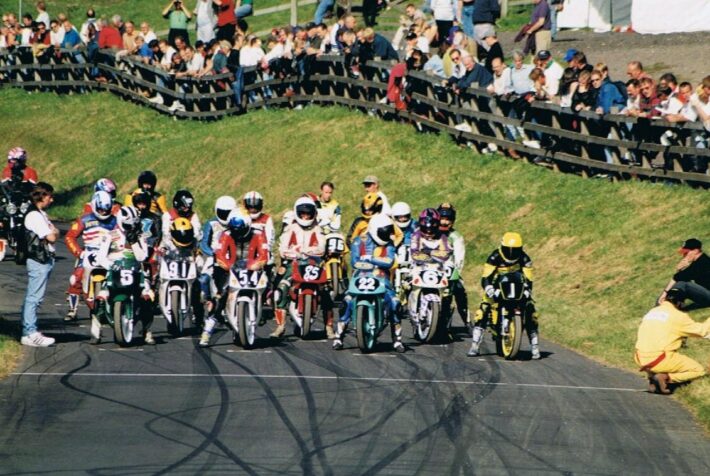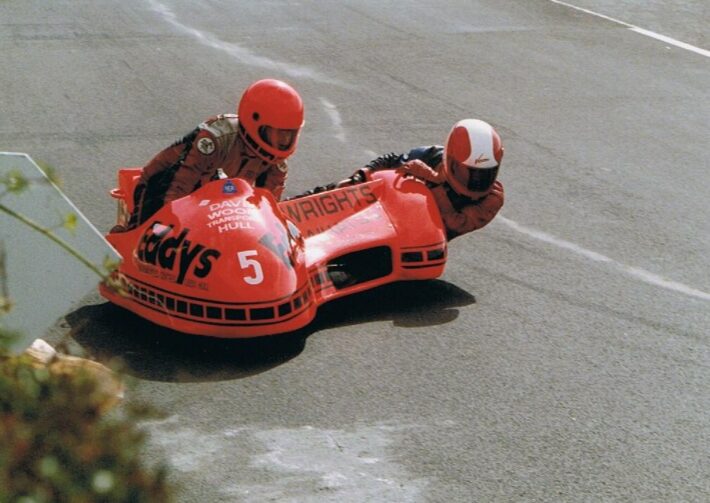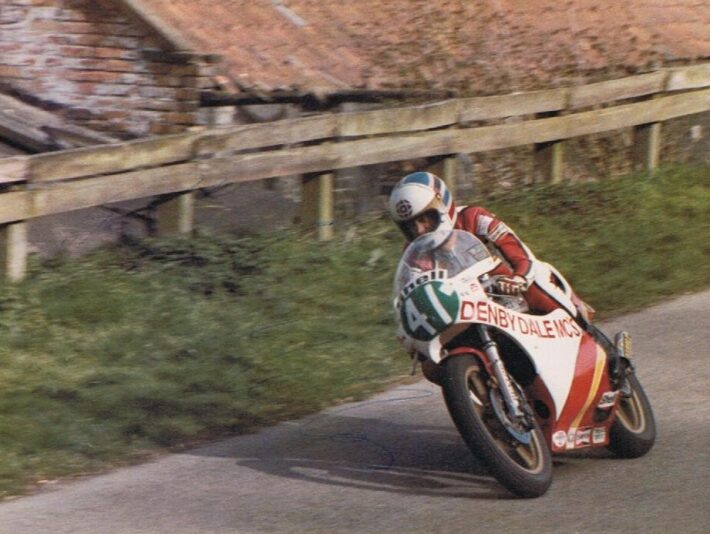Oliver’s Mount History
Oliver’s Mount is situated on high ground overlooking the seaside town of Scarborough in North Yorkshire and offers impressive views of the town. It also has a tribute monument to the war dead and a café as well as housing a broadcasting transmitter which provides TV and radio services to Scarborough and the surrounding areas.
However, it is primarily known for its motorcycle races with the course first seeing race action in 1946 and its layout has remained almost the same since those early days, the introduction of the Farm Bends section in 1991 (done to reduce speeds through the start and finish) the only alteration.
Oliver Cromwell
Oliver’s Mount, named after Oliver Cromwell, is the only public roads circuit in England and its origins stem from when some local entrepreneurs recognised the ‘feel good’ factor in the UK after the end of World War Two and decided the ideal way to welcome home the troops would be to host a race meeting. With its tight hairpins and steep climbs and descents, it represented a testing challenge for all competitors.
The circuit itself is 2.43 miles (3.91 km) in length and is not much more than a service road around Oliver’s Mount. However, it’s a technical, narrow and twisty track that requires a great deal of skill and bravery to tackle. Lined with trees and fences, the course is a mix of fast, twisty straights and slow hairpin bends with the famous jumps section a highlight for many. And 70 years after the first ever meeting was staged, it’s still going strong.
Start and Finish at Oliver’s Mount credit Phil Wain’s Family Archive
The circuit has played host to some of the world’s greatest road racers with the likes of Geoff Duke, Bob McIntyre, John Surtees and Phil Read all racing there in the 1950s and 60s. This trend has continued throughout the decades with Barry Sheene and Mick Grant the stars of the 1970s and 1980s whilst it is now the home of the leading road racers of the generation including Guy Martin, John McGuinness, Ian Hutchinson and Michael Dunlop.
International Gold Cup
Cast your eye over the roll call for the International Gold Cup, the biggest of the four meetings held each year, and you’ll see some illustrious names. And that’s just the winners. The list of riders who have ridden at the Mount reads like a who’s who of the sport and in addition to all those riders who have lifted the Gold Cup, when you add in the likes of Hailwood, Hocking, Amm, Saarinen, Katayama, Hennen, Gardner, Crosby, Lansivouri, de Radigues and Hislop you’ll get the picture.
Practically every Sidecar World Champion from 1955 to the early 1980s, including Scheidegger, Camathias, Deubel, Fath, O’Dell, Taylor, Biland and Schwarzel have also appeared at Oliver’s Mount as well as the cream of British crews over the years.
Eddy Wright in 1989 at Oliver’s Mount credit Phil Wain’s Family Archive
However, it hasn’t been all plain sailing for the circuit. Indeed, its existence almost came to an end in the early 1970s after a run of poor weather hit both attendances and finances hard. With the Japanese manufacturers pulling out of GP competition, racing in general wasn’t the battlefield it once had been and meetings at Oliver’s Mount were cut back to just one a year.
‘All or Nothing’ Strategy
In 1972, the organisers went for an ‘all or nothing’ strategy and it ultimately paid dividends. Reigning World Champions Giacomo Agostini, Jarno Saarinen and Klaus Enders were persuaded to venture over and the fans flocked back. As the decade progressed, the now legendary battles between Sheene and Grant saw tens of thousands of fans line the hillside and, indeed, Sheene won his last International race at Scarborough in September 1984 when he clinched his fourth Gold Cup.
After the 1972 meeting, the circuit and organisers regrouped with the Auto 66 club playing an integral part and the 1970s and 1980s would go on to be halycon days for the venue as it hosted all of the countries major Championships including the MCN Superbike, Vladivar Vodka 250cc and British Formula One series’.
Britain’s finest
Britain’s finest from this era can be found in the record books, amongst them Ray Pickrell, Dave Croxford, Peter Williams, Geoff Barry, Dave Potter, Roger Marshall, Tony Rutter, Phil Mellor, Charlie Williams, Trevor Nation, Rob McElnea, Mark Salle and Roger Burnett. The list goes on and on but as the 1980s progressed, Oliver’s Mount faced another stiff challenge as more concerns surfaced and with safety considerations increasing all the time, teams and manufacturers began to voice their concerns about competing for British Championship points on a public road circuit.
Phil Mello credit Phil Wain’s Family Archive
When Neil Robinson, one of the sports brightest stars, lost his life in a practice spill at Quarry Hill in 1986 on board the Skoal Bandit Heron Suzuki, the end was nigh. British Championship races lasted just two more years and September 1988 proved to be the final time the circuit hosted a round of the British Championship. Many felt at the time that it would never recover from such a major blow.
Financials difficulties
However, just as it had bounced back from the financial difficulties endured in the early 1970s, it did so once again. Star names like Carl Fogarty and James Whitham continued to race and enjoy their time at Oliver’s Mount and although a number of riders inevitably stayed away, circuit specialists came to the fore including David Jefferies, Dean Ashton, Lee Pullan, Jason Griffiths and Chris Palmer with Phillip McCallen and Neil Hodgson just two more names to taste success.
Fans continued to support the venue and a staggering 64,000 people witnessed the 50th Anniversary meeting in 1996 which featured Fogarty, Agostini, Read and Redman amongst the many stars in attendance.
More recently, the leading road racers have regularly been on the entry list including Ian Hutchinson, John McGuinness, Ryan Farquhar, Ian Lougher, Michael and William Dunlop and Guy Martin, the last named going on to be the most successful ever at the feature Gold Cup meeting having won the trophy, at present, a record eight times.
Check out the 2017 highlights…
Throughout 1990s and 2000s though, the most successful rider at Oliver’s Mount was Ian Lougher who has more than 130 wins to his name, a staggering total and one that includes everything from 125cc victories to success in all the feature trophy events. The circuit has also played a significant part in the career of Martin as it was here when he made his road racing debut in July 2002.
70th Anniversary of Oliver’s Mount
Life continues to throw up problems for the Auto 66 club and recent years have seen meetings abandoned due to fog, the paddock café damaged by gales and one of the footbridges demolished by a wayward truck. Its resilience knows no bounds though and this year sees it celebrate its 70th anniversary. A jewel in real road racing in the past, present and future, Oliver’s Mount will continue to have a highly important presence in the road racing calendar for many years ahead.
Throughout the year it hosts four weekends of motorcycle road racing and numerous hill climb challenges with the Spring National Road Races (April), Barry Sheene Classic Road Races (June), Cock o’ the North Road Races (July) and The International Gold Cup (September) drawing riders and spectators from all over the British Isles.
After the track closed for almost two years, it was announced in March 2019 that Oliver’s Mount had been taken over by a new road racing agency, twofourthree racing. There will be two road races held at Oliver’s Mount this year; Barry Sheene Classic Cup and The Gold Cup.
Oliver’s Mount Milestones
Check out these impressive milestones that have been set in the last 70 years…
1946 – Scarborough Corporation expresses a desire to celebrate the end of World War II with a ‘Welcome Home Week’ for servicemen and ask the local motor club to put on some form of ‘entertainment’.
1946 – Costing £920, the Corporation’s surveyor located a 2.4-mile race track on the picturesque wooded slopes of Oliver’s Mount.
1946 – The course was officially inspected on Sunday 15th September with 350cc races taking place on Tuesday 17th September and 500cc races on Thursday 19th September.
1946 – The first races were won by Denis Parkinson, Peter Goodman and Sid Barnett, with 12,000 people attending.
1947 – Maurice Cann wins the Lightweight race on a Moto Guzzi, the first win at Oliver’s Mount for a foreign-built bike.
1947 – Sidecar racing is introduced for the first time but only lasts one meeting.
1947 – BBC Radio starts transmitting commentaries with such luminaries as Graham and Murray Walker.
1947 – The start line moves from midway between the Esses on the top of the circuit to its current position on the bottom straight.
1950 – The first Gold Cup takes place with victory going to the works Norton of Geoff Duke.
1951 – September sees the first International meeting take place.
1954 – The circuit is re-aligned and widened with the sidecar class re-introduced.
1956 – Geoff Duke takes his fourth successive Gold Cup victory to make it five wins in total.
1957 – Live television coverage of the races takes place for the first time.
1957 – Mike Hailwood makes his debut, finishing second in the 250cc race.
1962 – For the first time, three meetings are held during the year.
1963 – Tommy Robb gives Honda their first Oliver’s Mount win with victory in the 125cc race.
1964 – Yamaha claim their first circuit win with Phil Read finishing first in the 350cc race.
1968 – John Hartle is killed at the International Gold Cup meeting.
1970 – Financial difficulties mean only one meeting, the Gold Cup, is held during the year.
1970 – Barry Sheene makes his Oliver’s Mount debut, taking a record breaking victory in the 125cc race. He also finishes second in the 250cc race and third in the 750cc.
1971 – The Auto 66 Club join the newly formed Scarborough Racing Circuits Ltd as part of the organising team.
1971 – Racing on Sunday takes place for the first time.
1971 – John Cooper becomes the first rider to win four races in a day with victory in the 250cc, 350cc, 500cc and 750cc categories in September.
1972 – Giacomo Agostini makes his only racing appearance at Oliver’s Mount and wins the Gold Cup, the first overseas rider to win the trophy.
1972 – World 250cc Champion Jarno Saarinen also attends the Gold Cup meeting and wins the 250cc, 350cc and Invitation races also claiming a new outright lap record.
1973 – Barry Sheene takes the first of his four Gold Cup victories.
1974 – Phil Haslam is killed resulting in brother Ron never competing at the circuit.
1975 – Phil Read wins the Gold Cup on the factory MV Agusta.
1977 – Sidecar World Champions George O’Dell, Werner Schwarzel, Rolf Biland and Jock Taylor all compete at September’s Gold Cup meeting.
1978 – Three meetings are again held during the year.
1981 – the Sidecar class is banned from the circuit in the interests of safety, the last Open Class win going to Dennis and Julia Bingham.
1981 – Barry Sheene sets a new outright lap record on his works 500cc Grand Prix Yamaha, which lasts for five years.
1981 – Australia’s Wayne Gardner, who would become the 1987 500cc World Champion, makes his one and only Scarborough appearance.
1982 – the Ken Redfern Trophy is held at Oliver’s Mount for the first time with victory going to Steve Henshaw.
1984 – Sidecars are re-introduced to Oliver’s Mount in the shape of the new Formula Two class; lap speeds are some 25 seconds down on those set previously in the Open class.
1984 – Joey Dunlop wins the Ken Redfern Trophy.
1984 – Barry Sheene wins his final race before retiring and takes his fourth Gold Cup victory.
1986 – Trevor Nation breaks Barry Sheene’s long standing outright lap record at the Cock o’ the North meeting.
1986 – Heron Suzuki rider Neil Robinson loses his life in a practice crash at September’s Gold Cup meeting.
1988 – The September Gold Cup meeting sees British Championship racing take place at Oliver’s Mount for the final time, James Whitham winning the feature British Formula One Championship race.
1989 – The Gold Cup is renamed the Steve Henshaw Gold Cup in memory of the Nottinghamshire rider who lost his life at that year’s TT. The Phil Mellor Trophy is also awarded for the first time.
1989 – Future World Superbike Champion Carl Fogarty wins the Gold Cup, taking seven wins from his seven races over the course of the weekend.
1989 – Fogarty sets a new lap record of 82.67mph which will never be beaten after the introduction of the Farm Bends section in 1991.
1991 – The Farm Bends chicane is added just before the start and finish in order to slow machines down along the bottom straight.
1991 – The Auto 66 Club acquire the shares held by the Scarborough Racing Combine.
1994 – Phillip McCallen sets a new outright lap record of 81.38mph which remains unbeaten for ten years.
1994 – Ian Bell, a solo winner in 1982, takes his first victory in the Formula Two sidecar class
1996 – The Auto 66 Club acquire the remaining shares held by the Scarborough and District Motor Club
1996 – The 50th anniversary meeting takes place in front of over 60,000 fans – Fogarty, Sheene, Read, Agostini and Redman are just some of the star names in attendance.
1999 – John McGuinness sets a new 250cc lap record at 80.04mph which remains unbeaten.
2000 – Having won the Cock o’ the North and Gold Cup trophies in 1999, John McGuinness completes the set by winning the Ken Redfern Trophy.
2001 – David Jefferies wins his fourth Gold Cup trophy.
2002 – Guy Martin makes his Oliver’s Mount debut at July Cock ‘o the North meeting.
2003 – Guy Martin wins both the Cock o’ the North and Gold Cup trophies for the first time.
2004 – Guy Martin breaks Phillip McCallen’s long standing outright lap record.
2007 – Guy Martin equals Geoff Duke’s tally of five Gold Cup victories.
2008 – Guy Martin takes a record breaking sixth Gold Cup victory in a row.
2008 – Nick Crowe and Mark Cox set a new F2 Sidecar lap record which remains unbeaten to this day.
2010 – Ian Hutchinson wins the Gold Cup for the first time to make it 10 International race wins in the year.
2010 – Ryan Farquhar becomes the first rider ever to lap the Oliver’s Mount circuit in less than 1m45s.
2011 – Ryan Farquhar becomes the first rider from Northern Ireland to win the Gold Cup.
2012 – Guy Martin wins his eighth Gold Cup.
2013 – Michael Dunlop becomes the first rider from the Dunlop family to win the Gold Cup.
2013 – Guy Martin sets a new outright lap record of 83.898mph.
2016 – Dean Harrison takes 24 race wins during the course of the season and takes the Gold Cup for the second successive year.
2017 – Harrison goes through the season undefeated, winning another 18 races, and also sets a new outright lap record of 84.630mph
2017 – The Gold Cup is cancelled for only the second time in the history of the event.
2018 – All Oliver’s Mount events were cancelled for the year.
2019 – Oliver’s Mount was taken over by a new company, twofourthree Road Racing association. There will be races held at the Scarborough circuit this year; Barry Sheene Classic Cup and the Gold Cup.
Check out the epic records and stats set at Oliver’s Mount…
Words by Phil Wain.



